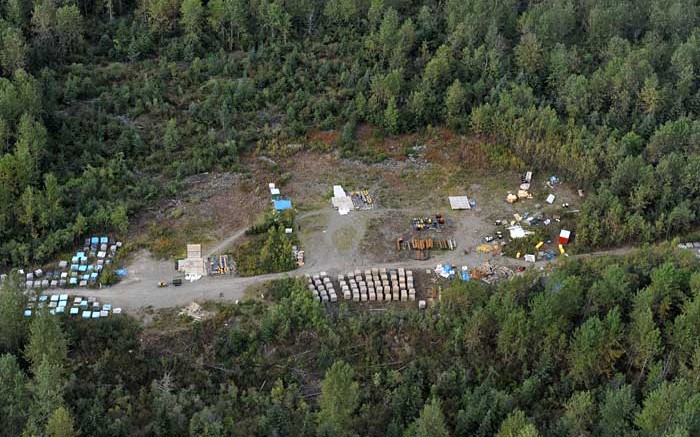Rudi Fronk and Jim Anthony were called “garbage collectors” when they started buying up uneconomic projects from the majors 15 years ago at US$260 per oz. gold. But their faith in higher gold prices kept them going and one of the first assets the pair picked up after founding Seabridge Gold (TSX: SEA; NYSE: SA) in 1999 was KSM, a project in northwestern B.C. that they bought from Placer Dome.
At the time KSM had two known deposits — Kerr and Sulphurets — which together had a resource of 3.4 million oz. gold and 2.7 billion lb. copper. Since then Seabridge Gold has added ounces at both Kerr and Sulphurets, discovered the Mitchell deposit in 2006 (which Fronk describes as the largest gold deposit ever found in Canada) and the Iron Cap deposit in 2010.
Altogether, reserves at KSM’s four large gold–copper porphyry deposits total 38.2 million oz. gold and 9.9 billion lb. copper from 2.2 billion tonnes grading 0.55 gram gold per tonne and 0.21% copper. KSM also has significant silver and molybdenum credits.
In late 2012, Seabridge discovered a high-grade core of copper lying underneath the Kerr open-pit deposit that it called “Deep Kerr”. And it recently completed a much-anticipated maiden resource on the zone that adds 6.1 billion lb. copper and 5.9 million oz. gold from 515 million tonnes at 0.36 gram gold 0.53% copper to KSM’s already robust economics.
“It’s a monster,” says Fronk, Seabridge’s chairman and CEO, “especially when you consider what we already have there in terms of reserves.”
The copper grade at Deep Kerr is more than two and a half times the average grade of the KSM project. It also remains open to the north and downdip, and some of the best intercepts last year came from drilling near the northern end of the deposit.
It leads Fronk and his team to believe that they might get even better grades as they continue to drill farther north and downdip.
This year Seabridge has committed the $16 million it raised from a flow-through financing late last year to its KSM project, and a good chunk of that will be devoted to Deep Kerr, says Fronk, who holds a B.Sc. in mining engineering and an M.Sc. in mineral economics from Columbia University. Some of the funds will also be spent on Iron Cap, where Seabridge discovered another high-grade zone underneath the main deposit last year.
Before finding Deep Kerr, Fronk notes, Seabridge viewed KSM as a gold project with a robust copper credit that would appeal primarily to gold miners as prospective partners. But with Deep Kerr’s confirmed copper profile, the zone opens up the potential for a joint venture with a large base-metal producer. And Seabridge is the first to admit it will need the help. An updated prefeasibility study for the KSM project in 2012 put the cost of building an open-pit and underground block-caving mining operation at US$5.3 billion.
“We recognize that this is a project of a scale beyond our own capability to develop,” Fronk says. “Our goal is to partner this asset up with a company that has technical and financial skills to build and operate a mine the size of KSM, and finding Deep Kerr only helps that plan. This is an asset that in the right hands can create tremendous value for our shareholders.”
Seabridge has confidentiality agreements with a number of gold and base-metal companies.
Seabridge is advancing the project while looking for partners, and expects to have its environmental assessment (EA) approved by the provincial and federal governments by mid-year.
Since 2006, Seabridge has spent $180 million on KSM between exploration, engineering and permitting activities, and Fronk calculates that given the project’s 38 million oz. gold reserves, the company’s cost rings in at $5 per oz.
Fronk believes that this part of B.C., 70 km north of the town of Stewart, is well on its way to becoming a major mining camp.
“Our next-door neighbour is Pretium Resources, and between ourselves and Pretium, we’re well through 100 million oz. gold and over 30 billion lb. copper resources,” he says. “This is one of the top-five largest mineral systems in the world and is effectively controlled by two companies. Over time this will develop into a mining district with multiple mines.”
Deep Kerr’s resource estimate was based on 32 core drill holes totalling 35,000 metres of drilling in 2012 and 2013, at a net smelter return cut-off grade of US$20 per tonne. In addition to gold and copper, the zone holds 30.3 million oz. silver and 32 million lb. moly.
Deep Kerr’s economic potential was evaluated using metal prices of US$3.30 per lb. copper, US$1,250 per oz. gold, US$23 per oz. silver, and US$14.40 per lb. moly, along with estimated metal recoveries from metallurgical test work.
The resource estimate was constrained by cost parameters derived from comparable block-cave mines operating around the world, totalling US$16 per tonne (US$6 per tonne for mining and US$10 per tonne for processing and G&A).
To make sure that the Deep Kerr resource did not overlap with the Kerr deposit that lies above it, the previously reported Kerr open-pit resource was isolated by a 50-metre buffer separating it from Deep Kerr.
Deep Kerr’s 515 million tonnes grading 0.53% copper compares favourably with Newmont Mining’s (TSX: NMC; NYSE: NEM) Batu Hijau project in Indonesia (439 million tonnes grading 0.40% copper) and Rio Tinto’s (NYSE: RIO; LSE: RIO) Bingham Canyon project in the U.S. (704 million tonnes grading 0.49% copper).
Seabridge is tightly held with the four largest shareholders — including co-founder Anthony — holding 35% of its shares.


Be the first to comment on "Seabridge tallies ‘monster’ resource at Deep Kerr"